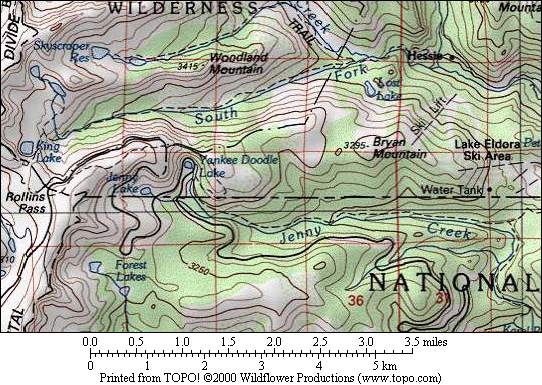
Date & Time: November 28, at approximately 1300 hrs.
Location: Yankee Doodle Lake, East side of Rollins Pass, Front Range, approximately 3.5 miles west of the Eldora ski area. Boulder County.
Elevation: 11,300 feet, at timberline
Aspect: Southeast (120 degrees)
Slope Angle: 34 to 36+ degrees

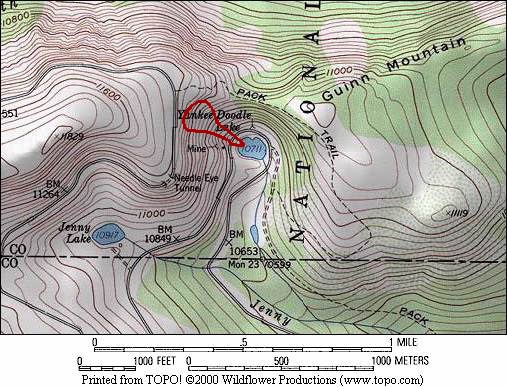
The avalanche was classified as HSAS3O/G (hard slab, artificial-skier trigger, medium size, running on old snow/ground). The crown (fracture line) was 2 to 5 feet, and 400 feet wide. About half way down the slope the avalanche was funneled to a width of 223 feet. The avalanche released from a southeast-facing slope and fell 600 vertical feet and stopped by crashing through the 10-inch thick ice of Yankee Doodle Lake. The displaced water resulted in a surge 10-12 feet tall along the south shore.
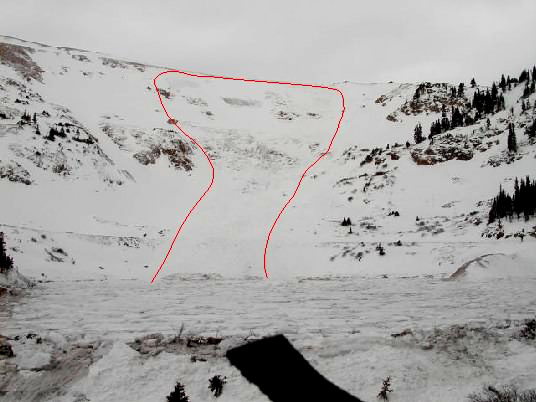
Photo taken on Nov. 29, looking northwest across Yankee Doodle Lake and up at the avalanche path. (Sorry about the pack strap.) (photo Atkins, 2001)
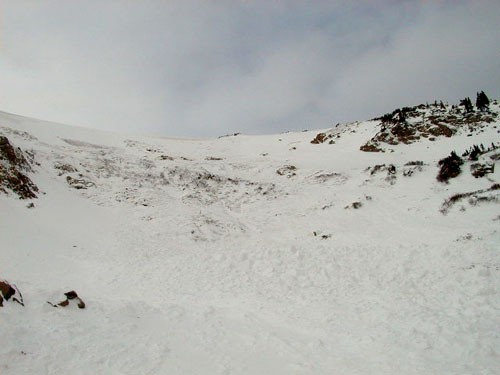
Photo taken on Nov. 29, from above the Rollins Pass road, looking up toward the crown (slightly left of center) at the top of the ridge. (photo Atkins, 2001)
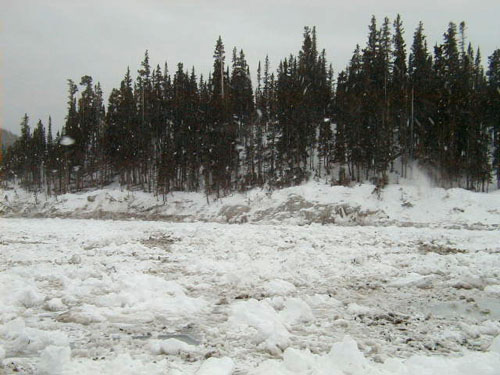
Looking across Yankee Doodle Lake toward the South shore. The water surge-height/ice-shove reached 10-12 vertical feet up the shore. A return wave sloshed back onto the debris. (photo Atkins, 2001)
The snowpack at the crown was uniform and hard (pencil) except at the ground. The bottom 2 inches consisted of soft (4 finger hardness), loose, beginning faceted (sugar snow). In places along and immediately below the crown was old summer snow or neve. (We were not able to safely approach the neve. There is a possibility this "old" snow is not neve but is more recent snow (October) that developed a hard melt-freeze crust.)

Weak layer along ground (Soft snow has been brushed away to highlight the layer.) This weak layer consisted of beginning faceted-snow grains of 1.5 to 2 mm in size that could easily be brushed away (4 finger hardeness). This layer was likely the result of light snows that fell on November 7-8. The overlying snow cover was caused by winds and the light snows since Thanksgiving. This layer was a uniformly dense hard slab (pencil hardness). The photo was taken on the skier's left (north) side of the crown. (photo Atkins, 2001)
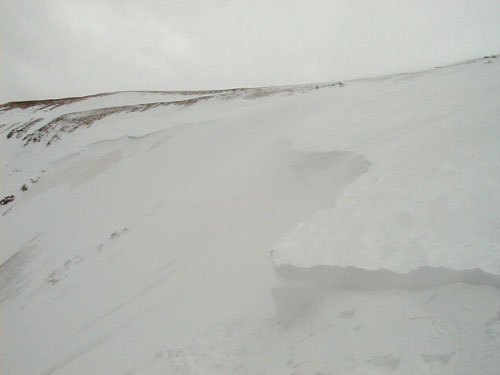
Photo taken on Nov. 29, looking across the crown from skier's right to left. Overnight winds had already drifted in parts of the crown. Visible is the old summer snow or neve (or possibly an early season melt-freeze crust). It was too icy to approach without an ice axe. (photo Atkins, 2001)
Weather data is still being collected. An estimated 12 inches of new snow fell in the area between November 23 and 28. "Heavy blowing snow" was reported at Eldora Mountain Resort on the night of November 26/27. The morning of the 28th dawned sunny.
Early Wednesday afternoon two local Boulder-county men were skiing the open slope above Yankee Doodle Lake when they triggered a sizable hard-slab avalanche. The avalanche struck the ice-covered lake and shattered the ice, dumping both men into the water. The pair were skilled and avalanche-savvy backcountry skiers who were well-equipped for a day in the mountains. One man died (drowned?). His friend escaped, but unable to find his missing partner, he hiked back to the Eldora ski area to get help.
This was the men's third day in a row on this slope where two days earlier they had enjoyed terrific powder skiing. Before starting their descent the pair dug a snow pit. Apparently satisfied with what they had found, they agreed to ski short distances one-at-a-time, taking turns watching each other while the other would wait at a "safe" spot. The first man (survivor) skied a short distance to flatter-bench area and traversed toward some rocks to avoid a much steeper cliff area. He glanced back over his shoulder and spotted his friend who had just started down. He then realized the entire slope was moving. The avalanche left both men in Yankee Doodle Lake.
The survivor ended up nearly in the middle of the lake approximately 190 feet from shore. Packed in shattered ice and water he struggled to the shore. Yells for his friend brought no response and he could not detect a signal from his friend's avalanche beacon. His waterlogged cell phone did not work, so he set out for help. He hiked down the Jenny Creek trail the 5 miles to Eldora Mountain Resort.
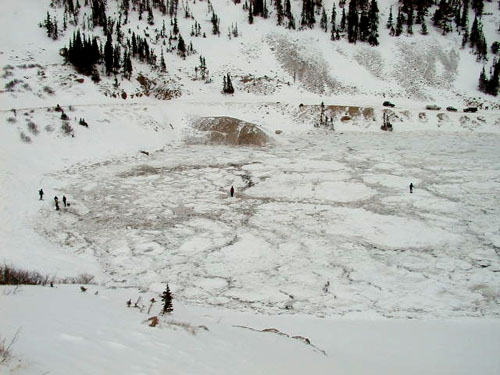
The man standing to the right marks the survivor's location, about 190 feet from shore. The man in the middle marks where the victim was found, 91 feet from shore. The men standing at the left are near the edge of the debris. The dirty snow around these men was the result of a wave washing back on to the debris. (Photo Atkins, 2001)
The Eldora Ski Patrol responded first followed by members of the Rocky Mountain Rescue Group. Arriving as darkness fell the hasty search was organized. Searchers tried to detect a beacon signal but could not, so probe poles were used to search likely burial areas. More rescuers arrived including avalanche rescue dogs. The rescuers could not search the shattered ice and water until later that evening when trained dive-rescuers arrived with specialized rubber suits. After 2300 hours that evening a dive-rescue team member searching the refreezing surface detected a signal. The missing man was found 91 feet off shore in the frozen snow, ice and water.
These men were smart and savvy backcountry skiers who were doing things by the book yet still got into trouble. At the time of the accident (and in the days before the accident) we were rating the backcountry avalanche danger in all mountain areas at CONSIDERABLE. Triggered avalanche releases were probable, and natural avalanches were possible on NW to NE to SE facing-slopes near and above tree line. The avalanche the men triggered occurred on an ESE to SE facing-slope at tree line.
Before rushing to judgment, remember both men were backcountry and avalanche smart. They had the right equipment and knowledge to be out in the terrain, snow, and weather conditions. Boulder County Sheriff George Epp said it well in the Daily Camera newspaper (11/30/2001, page 5A) when he was quoted "If you try to get a lesson out of this...the mountains can be dangerous no matter how prepared you are."
This is the first Colorado avalanche death in Colorado in the 2001-2002 winter, and second in the United States. Incidents where avalanche victims are swept into water and drowned uncommon but not unheard of. In 1978 at Twin Lakes, California, a county snowplow and a pickup with two occupants were swept into the unfrozen Lower Twin Lake. The snowplow operator swam to shore. Twenty minutes later a motorist stopped by the earlier avalanche climbed on to the debris where he was caught by a second avalanche and swept into the lake. All three motorists drowned. In 1981, near Elko, Nevada, a snowmobiler was caught and swept into an ice-covered lake and drowned.
Atkins 11/30/01